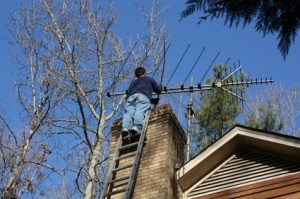Spring is the perfect time to get your chimney in tip-top condition for the fall. When the last of winter’s fires is out, no new combustibles are going up the flue and no new creosote is forming. So far, so good! Now it is time to remove the creosote that is already there and thoroughly inspect the chimney.

It is a mistake to think that the intervening months do not make a difference since the fireplace is not in use. While no new creosote is forming, what is there is developing into a problem. No longer kept dry by heated air, it now becomes damp. Creosote is corrosive anyway, and its interaction with moisture makes things worse. That interaction also releases gases, which may create a “musty” smelling fireplace.
After all your spring cleaning, it would be really obnoxious – and noxious! – for creosote gases to be what you smell. Furthermore, its corrosiveness means that the sooner you can get creosote removed from your flue liner, the more of its damage you can prevent. That ‘sooner is better’ rule applies to every part of your chimney, so inspecting it annually after a thorough cleaning is essential.
The goal is to actually see every part of your system, from its fireplace opening to the chimney cap we hope is there. Seeing requires a lot more than looking, because it sub-consciously involves activating ‘perceptual screening’ processes. Certified chimney sweeps are continually trained to see everything relevant to the safety of your fireplace system.
Catching a minor problem in spring stops it from developing into a major problem in fall. It also gives you time to correct the problem before you need to use the fireplace again. Last but not least to those who care about a house that smells clean, it improves the quality of the air you are breathing.
